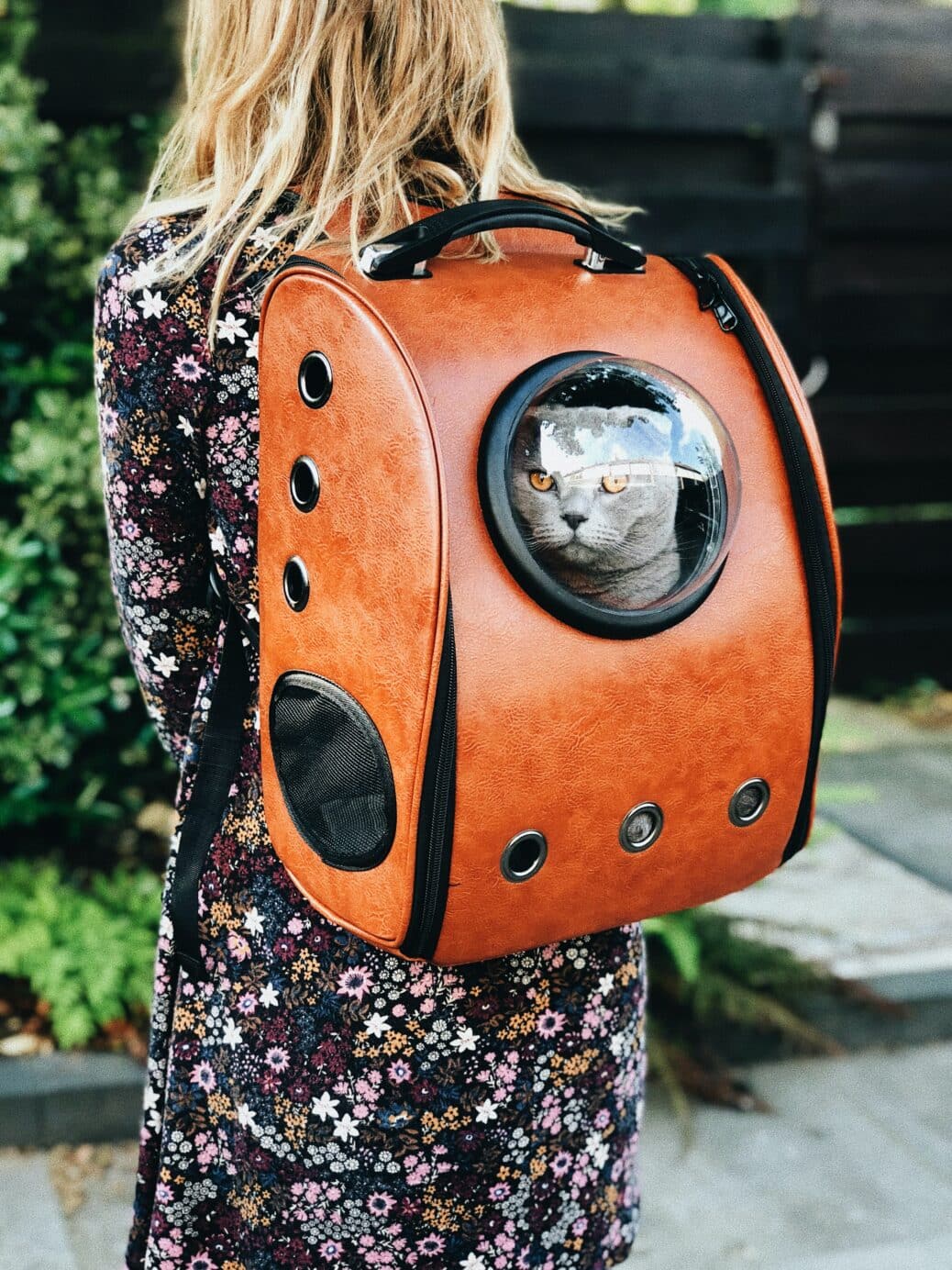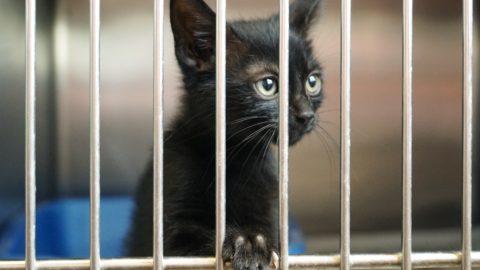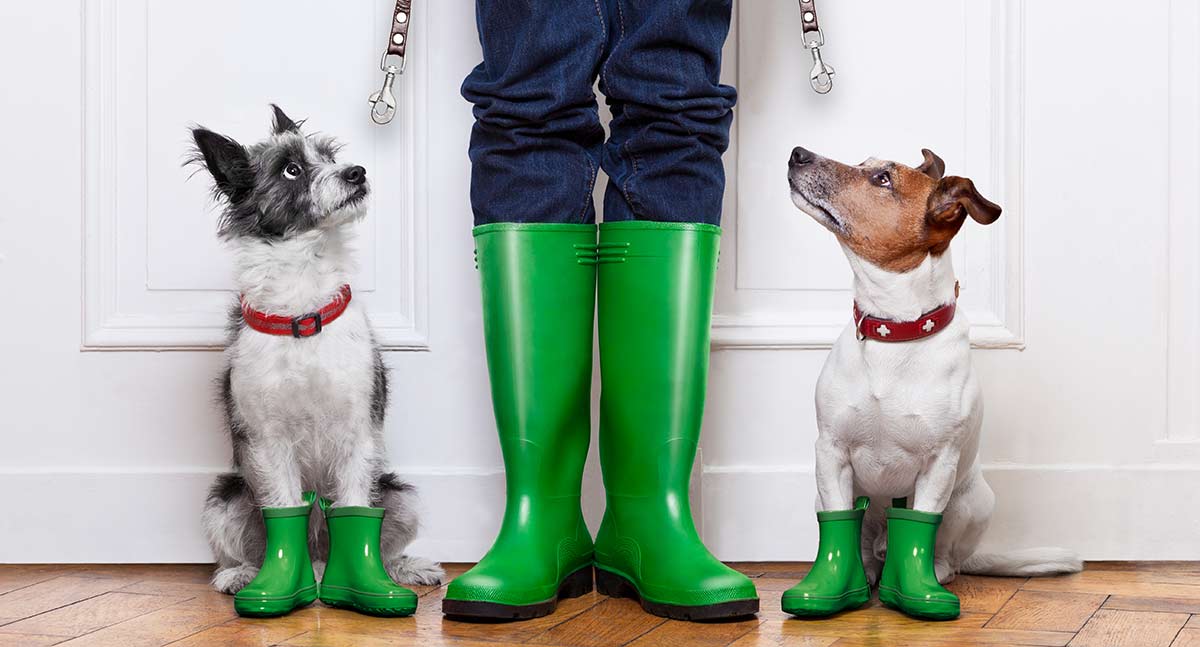How do cats use space? Part 2: Multiple & separated key resources
By Dr. Mikel Maria Delgado
Click Here for original post
In my last blog post, I covered a study that looked at how 14 cats in one home environment used their space. As you may have observed, space was a little “tight” for 14 cats, and some resources were lacking in number (notably, 4 litter boxes is not considered enough for 14 cats, so let’s just assume that we’ve come a long way in our understanding of how to care for cats since 1981).
There’s no doubt that the behavior of the cats in the study was impacted by the size of the home and the resources that were available. The more cats, the more chance for conflict or stress, illustrated by the one cat, Lily, who spent much of her time on top of the refrigerator.
To continue the space thread, I wanted to touch on some key principles we can follow to ensure that our cats are set up for success (read: reduce stress and behavior problems). Several years ago, a consortium of cat experts developed the Five Pillars of a Healthy Feline Environment. These are guidelines that ensure we are providing an optimal environment for our cats that improves their welfare and recognizes nature feline behaviors.
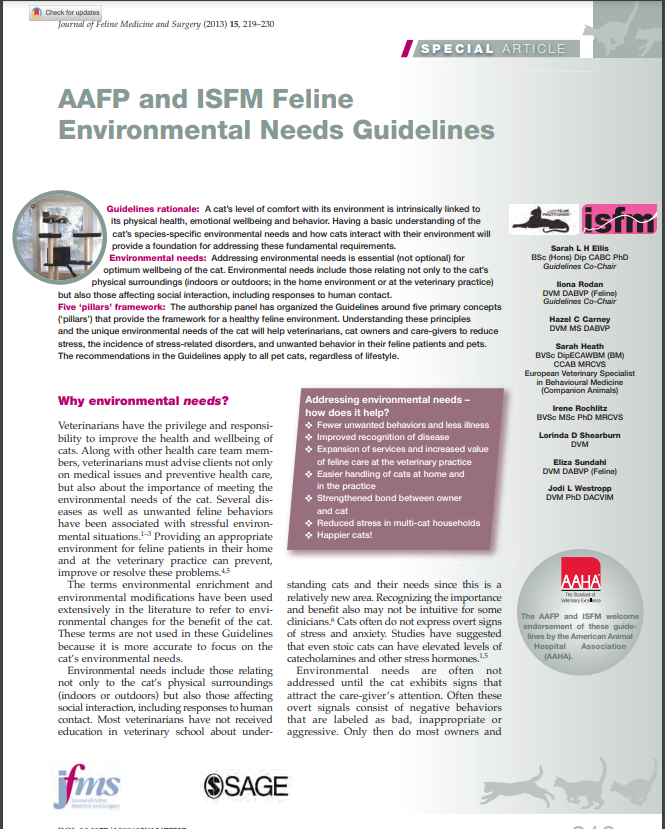
One of these pillars is: Provide multiple and separated key environmental resources. Key resources would include necessities like food and water, litter boxes, scratch posts, and areas to rest or play. Of note is that this pillar is important whether you have just one cat or…fourteen.
Let’s break that down: MULTIPLE means more than one of each. Ideally, for each of these key resources you have at least as many as you have cats, plus one extra (we call this the N+1 rule). Yes, that means one cat needs two litter boxes and two food dishes, and those fourteen kitties in the aforementioned research should have had at least 15 litter boxes!!
SEPARATED means that each of those resources should be in a separate area. Those litter boxes should not all be lined up side by side, but should be in different areas or rooms, ideally with several feet between them. The litter boxes should be away from the food dishes and scratching posts, and so on.
Cats in the corner
I’ve been in many clients homes where they had a “cat room” or “cat corner.” Often, they were very proud that their cat had a dedicated corner with their food, water, litter box and a scratch post – everything they needed in one convenient location!! Then I would have to burst their bubble and tell them it was time to let the cat have a little bit more space.
Have you ever moved into an apartment or house when someone had already been living there for years? They likely had photos on the wall, books on the living room shelves, the pantry was full of their pots and pans and spices and cooking staples. Although the room you’d be moving into was empty, the rest of the house was already “lived in.” Books and jars could be pushed aside, but it’s really hard to feel like you live somewhere when it feels more like someone has to make space for you, and the only space that is yours is the room you are renting. I imagine that’s kind of how our cats feel when we designate one corner as their “spot.”
Why cats need space
So why do we need to spread their stuff out? A few reasons that come to top of mind:
- To simulate natural behaviors – cats who roam freely have a large home range, with multiple and separate areas that they use for hunting, resting, and eliminating. They don’t naturally do these things all together.
- To reduce conflict – in multi-cat households, separating out the resources means that cats don’t have to wait to eat, they can choose to avoid cats they don’t get along with, and they can still access all the things they need to survive.
- To prevent cats from having to do things that aren’t pleasant. We use the saying “don’t sh*t where you eat” in a different context, but cats take that phrase literally.
A self-assessment exercise!
You can assess your own space by drawing a map. This is an exercise I have most of my clients do for several reasons. It helps me assess the home environment, and we can look at where some of those key resources could be increased or moved to optimize the use of the space (hopefully in a way that the humans can live with).
Start by just drawing a rough outline of your house. It doesn’t have to be perfect, but it should have all the rooms, with any large furniture drawn and labeled. Here’s my own house as an example.
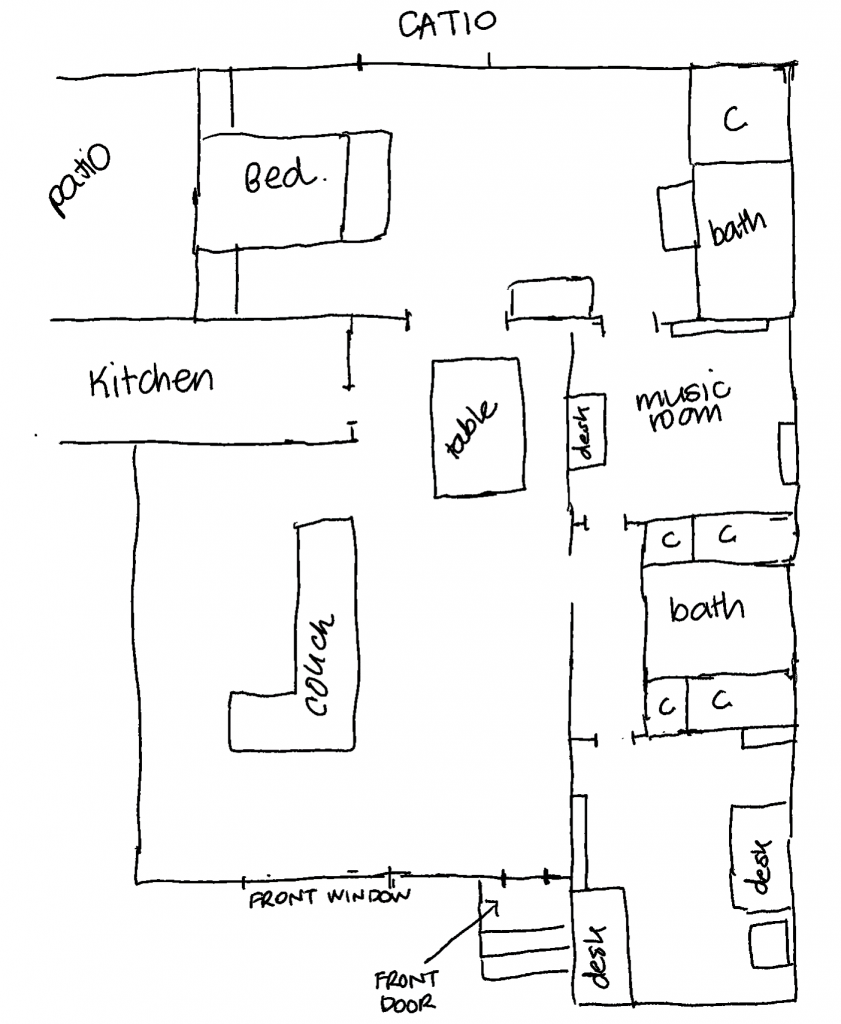
Now add your litter boxes, and food and water dishes. Do you follow the N+1 rule? Are your litter boxes in different locations? Do you have separate feeding areas so your cats can eat alone if they choose to? (The yellow boxes in the graphic below are litter boxes, the Xs are feeding areas and the blue waves represent water fountains).
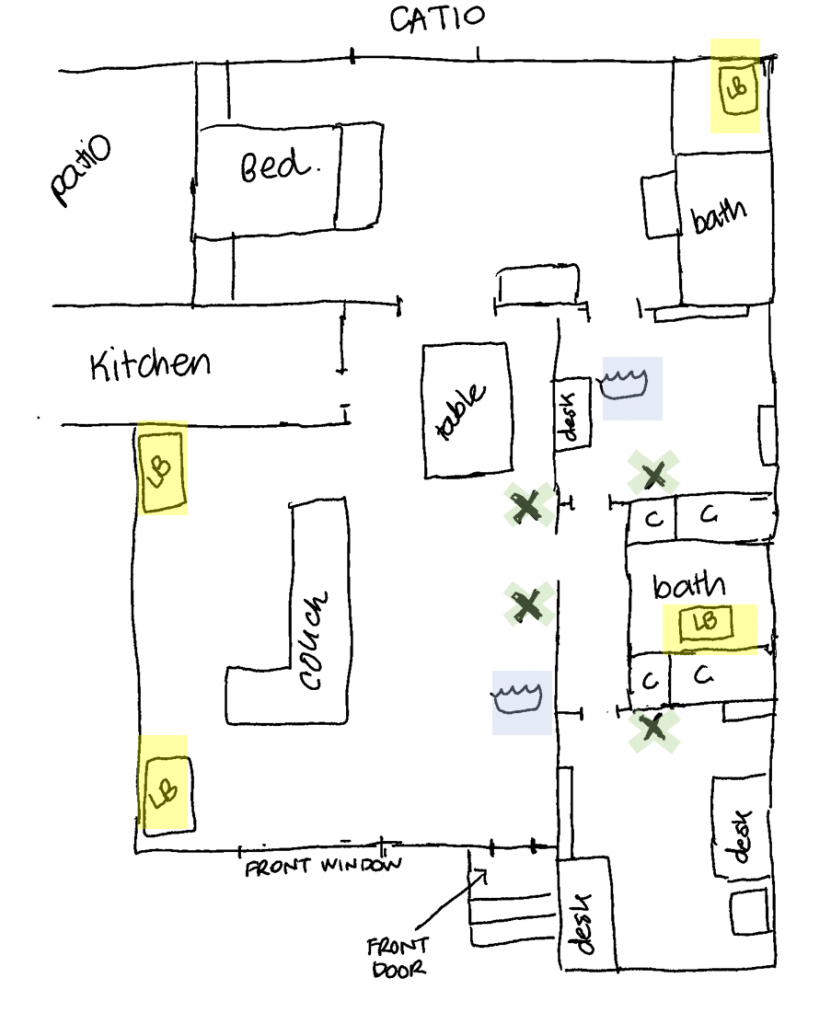
Now you can add the cat beds, cat trees (all which have sisal posts for additional scratching), and scratching posts. In this schematic, the bold circles are cat trees (I have four) and the bold squares are scratching posts, while the purple squares “B” are cat beds (there are 8 of them). The hashed-out rectangles are scratch pads.
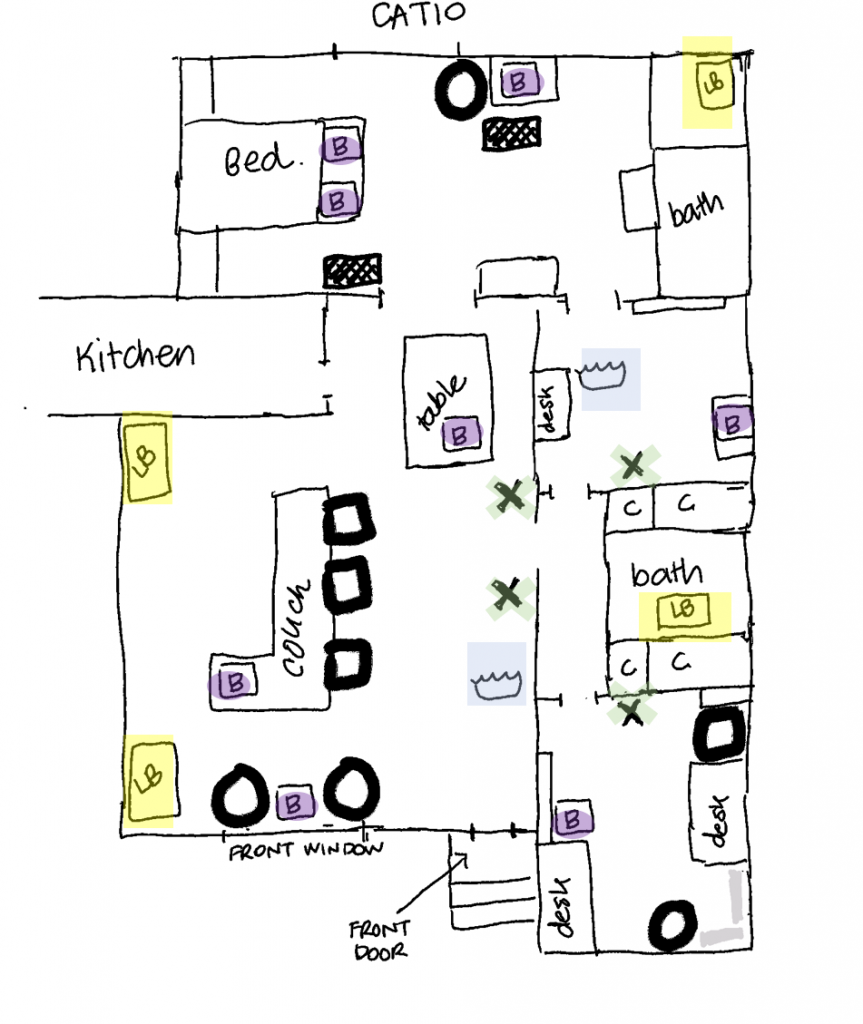
Now you try this exercise, and let me know what you find – feel free to leave me a note in the comments! How did you do? Did you discover some areas where you need to separate some cat things? Some windows that could use a cat tree? Are you lacking in litter boxes? Are your cats eating too close for comfort?
And if you find yourself feeling a little irritated with the thought that you have to make more space for your cats — as my dear friend Jackson Galaxy said in our book Total Cat Mojo: “You have just come face-to-face with the fact that cats aren’t the only territorial animal in your home.”
In my next blog post, I’ll discuss how we can further assess this map to see what it tells us about relationships between multiple cats!
References
Ellis, S. L., Rodan, I., Carney, H. C., Heath, S., Rochlitz, I., Shearburn, L. D., … & Westropp, J. L. (2013). AAFP and ISFM feline environmental needs guidelines. Journal of feline medicine and surgery, 15(3), 219-230.
Kitts-Morgan, S. E., Caires, K. C., Bohannon, L. A., Parsons, E. I., & Hilburn, K. A. (2015). Free-ranging farm cats: home range size and predation on a livestock unit in Northwest Georgia. PloS one, 10(4), e0120513.

